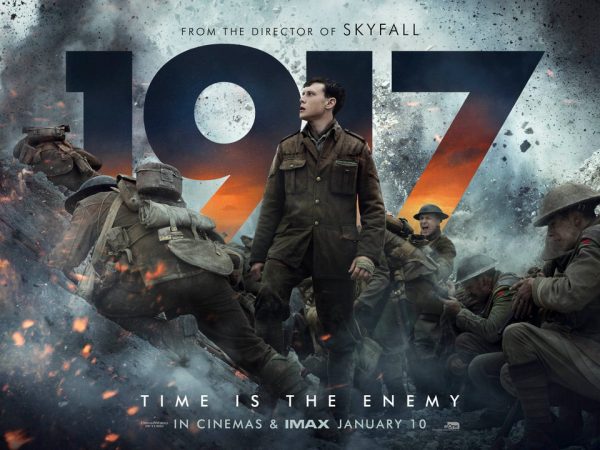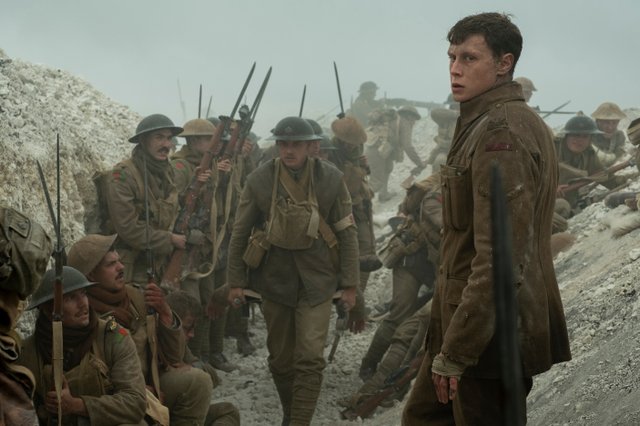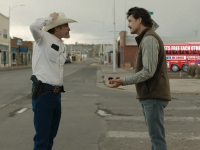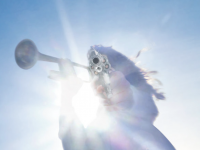
 During the First World War, in April 1917, two British soldiers journey across no-man’s land and into enemy territory on a desperate mission to save 16,000 allies from a German trap.
During the First World War, in April 1917, two British soldiers journey across no-man’s land and into enemy territory on a desperate mission to save 16,000 allies from a German trap.
Noticeably flagging in interest with his last film, the rote James Bond sequel Spectre in 2015, director Sam Mendes has returned from a near five-year absence with 1917. Dedicated to his grandfather, Alfred Mendes, and inspired by his stories of the First World War, 1917 is not only a return to form for the filmmaker, but quite possibly one of the most accomplished films I have ever seen. It succeeds on so many fronts, achieving its visceral, emotional goals so fluently that it is a miracle to witness it rise to the lofty ambitions of its production. The first trailer I saw for 1917 was a strange one – rather than a traditional, narrative-driven teaser, the most popular advertisement was a behind-the-scenes look at the production: namely, the ‘one-shot’ nature of its filming. As fascinating and effective as this was, it gripped me as a fan of film making more than it did of 1917 as a film. Going in, I knew that I would be impressed by its technical accomplishments. What I failed to anticipate, however, was just how emotionally impactful I would find this marriage of story and production.
I’ll start with what is in front of the camera. Young actor Dean-Charles Chapman, known to some as the supporting character Tommen Baratheon on Game of Thrones, is incredibly endearing in the lead as Lance Corporal Tom Blake. His youthful energy fits perfectly as the dedicated but ultimately naïve soldier, and Chapman knows how to play Blake’s armour of strength beautifully. Alongside Blake is Lance Corporal Will Schofield, played by the fantastic George MacKay who I know best for his role in 2014’s excellent Pride. MacKay’s quieter, more reserved character plays perfectly off of Chapman’s Blake, with Mackay seamlessly developing the emotional mystery surrounding his character as the film progresses. To see these young actors (known mostly for supporting roles) play the leads in a film of this scale, and with such dedication, only adds to the narrative of following these two normal soldiers on a perilous mission. Solidifying this level of authenticity is the environment the actors are given. The sets feature an astonishing level of detail: from the muddy horror of a war-torn field as the pair venture across no man’s land, to the long, labyrinthine trenches lined with soldiers socialising, struggling or disturbingly harmed. There is a palpable, real atmosphere to every single location, a dedication to displaying each detail – from the slip of a boot on wet mire, to the cruelty inflicted upon the innocent animals that lay on the battlefield. Each actor nails these soldiers’ physicality, and their interaction with this immaculately recreated setting makes their commitment all the more commendable.
This leads me to the much-touted work done behind the camera, and the results are as arresting as the advertisements made them seem. Mendes cut his teeth on the ‘one-shot film’ technique with Spectre’s opening ‘Day of the Dead’ festival scene (easily the best scene in that movie), and here he creates an entire film around it to remarkable effect. Those familiar with the tricks done to achieve this filmmaking flourish will notice the cuts – the moments where something passes by the camera to mask an edit – but the length of some scenes in 1917 are nothing short of astonishing. It is immediately clear that giant sets were constructed to achieve the immersive look of this film, with cameras being passed along multiple talented operators while actors perform live, with pin-point timing being essential to pull it all off. Mendes is assisted in the magnificence of these shots by cinematographer Roger Deakins, who is perhaps the most prolific cinematographer in film history. He brings his usual flair to 1917, lighting and compositing each scene with breath-taking aplomb. Combined with Mendes’ heartfelt direction, it is a fine example of two artists at the top of their game. The soundtrack from Thomas Newman is also perfectly placed and weaves the scenes together, maintaining a rhythm despite the lack of cuts, like its own form of editing. This all accomplishes a totally engrossing, unflinchingly arresting filmic experience, and for the two-hour runtime you are hooked in its reality. It is absolutely transporting.

There is argument to be made about Mendes creating a spectacle of the Great War, and I would not argue against anyone who feels this way. Indeed, our characters do go through a consistent series of perils to the extent that it may feel synthetic to some, and I understand this sentiment. To myself, however, the film fully achieves its goal of placing you right next to the men who suffered the horror of the First World War, and its escalating excesses simply add to the exhaustion these men felt regularly when asked to do what could be seen as simple missions by their superiors. It is difficult to show the limitless dread of war in two hours, and 1917 does display an extreme vision of the two soldiers’ mission. But in keeping the danger ever present, and the fear persistent, the audience is positioned unwaveringly in its emotive grasp. I haven’t felt this connected to the tragedies of the First World War since watching Peter Jackson’s striking 2018 documentary They Shall Not Grow Old, showing how two different cinematic methods of exploring this period are equally as affecting. By the end of 1917, I had tears in my eyes and a desperate desire to recommend it to everyone.
One of my favourite films in years, 1917 is gripping, heart-breaking, and a stunning accomplishment in displaying the power of cinema to tell our stories and histories.

Author: Tom, Chelsea store





